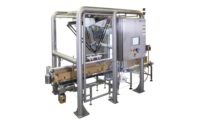According to a recent study from PMMI, The Association for Packaging and Processing Technologies, the number of manufacturing locations using robots has more than tripled since 2008. Providing cost savings, improved performance, greater safety and enhanced sanitation, automation is revolutionizing food manufacturing — including the processing and packaging of meat products. Today, manufacturers in the meat industry can find a number of next-generation automation solutions to solve challenges in innovative ways.
Better than 20/20
Enhanced vision capabilities are leading to the increasing use of robots. The “eyes” of a robot can identify the dimensions and orientation of an item. They can pick up color and are even able to adjust their focus based on changing light conditions. These advances in sensor technology have refined the robot’s precision, enabling gentler handling and the handling of smaller products.
A different, and very important, type of vision capability in robotics for food processing is the integration of X-ray technology. Many of today’s X-ray systems employ dual energy algorithms, meaning they use two distinguished beam energies for scanning. This increases the differentiation capabilities of the machine and makes them increasingly sensitive to a wide range of contaminants, including bone fragments, glass, metals, wire, rubber and even some plastics.
Sanitary design
|
Next-generation automation for the meat and poultry industries. |
Relentless efforts by meat product processors to enhance both food safety and sustainability have enabled robot solutions to move from palletizing applications to direct contact with food. The FDA’s approval of wash-down robots and end-of-arm-tooling devices for use in food handling have made these automated solutions available to improve food safety by limiting human contact — one of the most likely sources of contamination — in tasks such as meat cutting.
Designing machines with smooth surfaces, no corners, and coatings enabling resistance to the corrosive effects of bacteria-killing chemicals, allows for more thorough wash downs. These characteristics enable robots to work throughout the manufacturing line, broadening their role in improving the operation of today’s meat processing and packaging facilities.
Brains behind the brawn
Behind the capacity to lift heavy loads and work at a more consistent pace than most humans lies the software that is the robot’s brain. Advances in software have made programing easier than ever before. Robot manufacturers are more seamlessly integrating with the PLC. This has essentially provided an open platform for users, allowing all machines on the line to interface with each other regardless of their proprietary programming languages.
The future of automation
Automation will continue its expansion in the meat processing and packaging operations. Industry professionals seeking the latest solutions can turn to PACK EXPO International 2014 (Nov. 2-5; McCormick Place, Chicago). Co-located with Pharma EXPO, a new event launched by PMMI and the International Society for Pharmaceutical Engineering (ISPE), the events are expected to feature processing and packaging solutions from more than 2,000 suppliers and attract 50,000 attendees.
Tom Egan is vice president, Industry Services, for PMMI — The Association for Packaging and Processing Technologies. PMMI represents more than 650 packaging and processing supply chain companies that provide a full range of packaging and processing machinery, materials, components and containers. To learn more about PACK EXPO International 2014 and to register for the show, visit www.packexpointernational.com. To learn more about PMMI, visit PMMI.org.






Report Abusive Comment